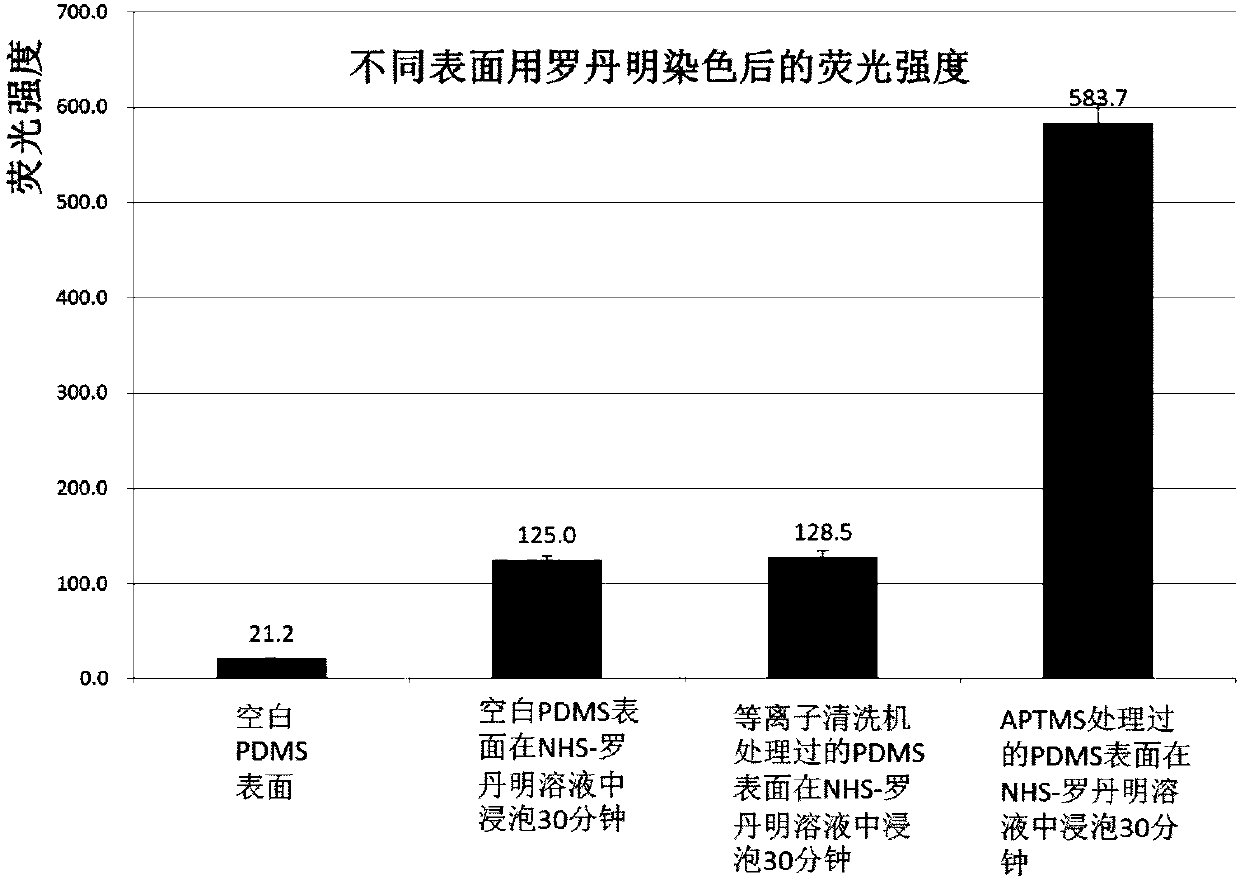Micro-fluidic chip as well as modifying method and application thereof to detection of quantity of food bacteria
A microfluidic chip and modification technology, applied in chemical instruments and methods, laboratory containers, instruments, etc., can solve the problems of high requirements for surface modification of microfluidic materials, achieve fast detection time and reduce infection risk Effect
- Summary
- Abstract
- Description
- Claims
- Application Information
AI Technical Summary
Problems solved by technology
Method used
Image
Examples
Embodiment 1
[0048] A method for modifying a microfluidic chip, comprising the following steps:
[0049] (1) Put the microfluidic chip of polydimethylsiloxane (PDMS) into the plasma generator to react, the reaction conditions are: the pressure is 100mTorr, the power is 118W, and the reaction time is 10 seconds. The purpose is to put the –CH on the inner surface of the microfluidic channel 3 The group is transformed into a -OH group;
[0050] (2) After the reaction of the step (1) is completed, the mixed solution of APTMS (aminopropyltrimethoxysilane) and dehydrated alcohol is passed into the micro-flow pipeline to carry out silanization reaction, wherein the mass ratio of APTMS is 5%, after reacting for 30 seconds, air was blown to dry the remaining mixed solution in the microfluidic channel, and dried naturally at room temperature. This step can introduce amino groups on the surface of the microfluidic channel.
[0051] (3) After drying, the seventh-generation PAMAM dendrimer whose surf...
Embodiment 2
[0072] Using the same method as in Example 1, the only difference is that the grafted dendrimers are PAMAM G4 (the fourth generation PAMAM dendrimers). For the schematic diagram of the reaction, see figure 1 .
[0073] After the above-mentioned modification was completed, the Escherichia coli in the sample to be tested was detected by the same detection method as in Example 1, and the detection results are shown in Table 1.
Embodiment 3
[0075] Using the same method as in Example 1, the only difference is that the grafted dendrimers are PAMAM G9 (ninth generation PAMAM dendrimers).
[0076] After the above-mentioned modification was completed, the Escherichia coli in the sample to be tested was detected by the same detection method as in Example 1, and the detection results are shown in Table 1.
[0077] From Figure 5 It can be seen that the detection limit of grafted PAMAM G7 to Escherichia coli is 10 2cells / mL, the detection time is within 4 hours, and the detection limit of most existing optical microfluidic devices is 10 4 cells / mL, therefore, after the modification of Example 1 of the present invention, it can far exceed the existing detection equipment.
[0078] Wherein the detection performance of embodiment 1 of the present invention is higher (antibody modification detection limit is 10 4 ), the reason is that each G7 macromolecule can graft one antibody due to the larger volume of the antibody (a...
PUM
 Login to View More
Login to View More Abstract
Description
Claims
Application Information
 Login to View More
Login to View More - R&D Engineer
- R&D Manager
- IP Professional
- Industry Leading Data Capabilities
- Powerful AI technology
- Patent DNA Extraction
Browse by: Latest US Patents, China's latest patents, Technical Efficacy Thesaurus, Application Domain, Technology Topic, Popular Technical Reports.
© 2024 PatSnap. All rights reserved.Legal|Privacy policy|Modern Slavery Act Transparency Statement|Sitemap|About US| Contact US: help@patsnap.com










